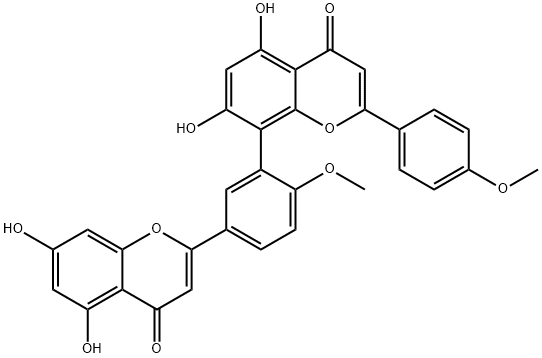Description
Isoginkgetin is a biflavonoid that has been found in
G. biloba and is an inhibitor of pre-mRNA splicing. Isoginkgetin (33 μM) reduces the activity of an mRNA-dependent luciferase reporter by 5-fold, shifts the composition of total RNA extract from predominantly mRNA to pre-mRNA, and arrests cell growth in HEK293 cells. Isoginkgetin (10 μM) suppresses mouse lymphocyte proliferation induced by concanavalin A (Con A; ) and LPS by approximately 87 and 90%, respectively. It also suppresses arachidonic acid release induced by phorbol 12-myristate 13-acetate (PMA; ) and the calcium ionophore A23187 by 32.5 and 48.4%, respectively, in rat peritoneal macrophages when used at a concentration of 10 μM. Isoginkgetin (5-20 μM) reduces matrix metalloproteinase-9 (MMP-9) activity, expression, and mRNA levels in and decreases cell invasion by HT1080 fibrosarcoma cells in a concentration-dependent manner.
Definition
ChEBI: A biflavonoid resulting from the formal oxidative dimerisation between position 8 of one molecule of 5,7-dihydroxy-4'-methoxyflavone and the 3' position of another. Found in the leaves of Ginkgo biloba, it is a potent inhibitor of matrix metal
oproteinase 9 (MMP-9).
Origin
Isoginkgetin (ISO), a member of the biflavonoid family, could promote autophagy in HCC cells and human colon carcinoma cells HCT 116. As a natural compound derived from Ginkgo biloba leaves, ISO possesses anti-tumor and anti-splicing functions. Nevertheless, ISO's low water solubility and poor bioavailability hinder its biomedical application [1].
General Description
A cell-permeable, naturally isolated
Ginkgo biloba biflavanoid that acts as a general pre-mRNA splicing inhibitor (IC
max = 50 μM in splicing assays using HeLa nuclear extract) by blocking the spliceosome-meidated splicing process at the prespliceosome/A complex stage. Isoginkgetin treatment is shown to result in growth arrest in HEK293-derived cultures in a reversible manner without affecting cell viability (33 μM for 24 h).
Mechanism of action
Specifically, isoginkgetin impairs the production of matrix metalloproteinase 9 (MMP-9), a protein involved in tumor invasion and metastasis, via inhibition of the NF-κB pathway and upregulation of the MMP-9 inhibitor tissue inhibitor metalloproteinase 1 (TIMP-1) in human fibrosarcoma cells. Isoginkgetin inhibits the activity of the 20S proteasome, leading to a toxic accumulation of ubiquitinated proteins in the ER and the induction of apoptosis in cancer cell lines. Like other proteasome inhibitors, isoginkgetin also inhibits the NF-κB pathway, which relies on proteasomal degradation of the inhibitory protein IκBα for activation. Moreover, the disruption of proper protein clearance via proteasome inhibition results in the activation of lysosome regulator TFEB, UPR, and autophagy pathways[2].
References
[1] Yang Wang . “Isoginkgetin synergizes with doxorubicin for robust co-delivery to induce autophagic cell death in hepatocellular carcinoma.” Acta Biomaterialia 153 (2022): Pages 518-528.
[2] Jessica Tsalikis. “Isoginkgetin, a Natural Biflavonoid Proteasome Inhibitor, Sensitizes Cancer Cells to Apoptosis via Disruption of Lysosomal Homeostasis and Impaired Protein Clearance.” Molecular and Cellular Biology 39 10 (2019).


